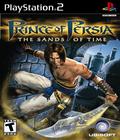Q : Who has the honor to talk to us? State your name, rank and occupation!
My name is Yannis Mallat and i am the Producer for UbiSoft's upcoming product Prince Of Persia – The Sands Of Time.
Why did Ubi Soft decide to bring the Prince of Persia license back to life?
YM : The Prince of Persia games were among the coolest PC games ever. We wanted the huge numbers of people who are playing on next-gen consoles (including lots of the original Prince of Persia fans) to be able to experience the game. We’ve really captured the magic of the Prince of Persia brand and pushed the capabilities of the next-gen consoles, and we can’t wait to unleash Prince of Persia: The Sands of Time.
Q : When and how did the whole “Prince of Persia – The Sands of Time” project start within Ubi Soft?
YM : We began the conception phase at Ubi Soft’s Montreal studio in May 2001, but things really got rolling when Jordan Mechner watched our first mock-up a couple of months later. It was an amazing experience – Jordan was absolutely blown away, and the core team has been moving full steam ahead since then. Once the conception phase was completed, and we had several conceptual AVIs illustrating how the Prince could move and interact with his environment, we began the technical engine study phase. After selecting the right engine, we began training the core team on the technology – and pre-production began. So there have been a number of ‘beginnings’ as the project has evolved.
How many people were involved in the initial stages of the project? What were their specific roles?
YM : From May to September, seven people were involved. They were:
- Two game designers: Defined the main concept, helped build prototypes in real time with the technical team
- One animator: Built the major moves, gave life to the Prince through his movements. We started with these because we felt it was most important to define the Prince by his moves first.
- Two engineers: Started the engine study, supported the design team in conducting gameplay tests
- One concept artist: Illustrated game design ideas for locations, environments, initial art direction (as much as possible at this stage). Also helped with creative ideas!
- One producer: Me! I was also humbly acting as a game designer and creative consultant – and loving it.
What did this famous license evoke to you before you started working on the “Prince of Persia – The Sands of Time” development process?
YM : I always felt the original game revolutionised the gaming industry. It became the standard of the time and an instant “classic,” and represented great Action-Adventure gaming, strong settings and compelling storytelling. Working on the fourth instalment of this well-known franchise has been quite a challenge and a great honour for the whole team.
To meet this challenge, we have both followed in the footsteps of the legendary games and created something new that will amaze the contemporary gaming world. We can’t approach this new title thinking that it is just another game… it is part of something bigger… and so that is what the gamers will get!
How did you prepare yourself and your team: what were the references, inspiration sources (history, music, movies, books…) for this development?
YM : The Arabian Nights book – 1001 Tales – was required reading for the development team. It gave us a great, immersive sense of the Arabian fantasy feeling; it’s imaginative and crosses boundaries – exactly what we’re doing with the game.
As for the moves, the team was inspired by Hong-Kong action movies such as Crouching Tiger, Hidden Dragon and the Jet Li action films. We also watched several Capoiera documentaries – it’s a Brazilian fighting style that intricately melds martial arts with stylized dance. The story is that ancient Brazilian slaves were not allowed to fight against each other, so they simulated a group dance. People would clap their hands and pound on drums, surrounding the two people who were actually fighting; if they were approached, the fight could easily be disguised as a strange, fluid, acrobatic dance.
Of course, we also watched every Hollywood movie on the 1001 Nights tales, to see the clichéd treatment of the subject. And we all played Prince of Persia 1&2 incessantly, to really understand what makes the license so incredible.
What kind of competitors’ games did you carefully analyse and why, when setting up the “skeleton” of your project?
YM : Most action/adventure games today build upon the original Prince of Persia, so they offer interesting aspects for the conceptual development of the game. They helped us evaluate what we wanted Prince of Persia: The Sand of Time to be, compared with other games, and how we could go about establishing new standards for the genre – just as the original game did.
We looked closely at games such as Shinobi, the Onimusha series, Devil May Cry, Tomb Raider and even some older licenses that are making a comeback (like Rygar and Ninja Gaiden). Of course, building a strong foundation for the latest Prince of Persia game also involved a careful examination of the previous titles.
Why did you choose to develop a completely new game rather than doing a sequel to the previous Prince of Persia, released in 1999?
YM : We really felt that the ‘true’ Prince of Persia essence was best captured by the first two games, and that drawing inspiration from the original titles was the best way to bring the license successfully to Next Gen consoles. The question brings up an interesting point, though: Prince of Persia: The Sands of Time is in fact an original creation itself. Apart from the name, everything has been built from scratch – redesigned, rethought: the Prince, the environments, the game design, the story. It’s all bigger, stronger, better. Trust me; it was no piece of cake, but it was the only way to ensure that the game will live up to the legacy of the brand.
What elements of the brand did you have in mind, at the beginning of the project?
YM : We studied the first two games intensely, playing long hours to truly understand the source of the magic. Three major elements struck us:
- The astonishing animations and character movements
- The intense fight sequences
- The clever and challenging level design and the gameplay built around that design
The team considered these the main strengths of the license, and we focused on those from the beginning – both because they’re faithful to the essence of the brand and, if done well, the universal recipe for a stellar action/adventure game.
What were your main priorities when the development got started? Did these objectives imply a specific organisation of work within your team?
YM : As with any original creation, building a playable area around the main character’s behaviour was the first priority. We knew very early that the whole concept would depend on the immediate appeal and intuitive controls of the Prince. No final level construction could start before we mastered that.
Of course, this implied a specific organization of the team as we wanted the core to focus on this crucial goal. But we also wanted to experience this playable on the real engine, on the real platform, with all the constraints that implies. So we sent the core engineer team to another Ubi Soft studio to learn the engine we chose for the game.
Once we were satisfied with the playable’s feel, movements, and basic gameplay, we focused on character design for the Prince, and then on environments and art. In a nutshell, we focused first on the gameplay basics – the things that make the game fun to play; then we focused on the dressing of the game – the things that make it beautiful to look at. And we also achieved a technical breakthrough very early on, but you’ll have to wait to hear more about that!
Thanks you for taking the time to answer our annoying questions!
YM : You are most welcome
More articles about Prince of Persia: The Sands of Time











 A rogue prince reluctantly joins forces with a mysterious princess and together, they race against dark forces to safeguard an ancient dagger capable of releasing the Sands of Time, which can reverse time and allow its possessor to rule the world.
A rogue prince reluctantly joins forces with a mysterious princess and together, they race against dark forces to safeguard an ancient dagger capable of releasing the Sands of Time, which can reverse time and allow its possessor to rule the world.


